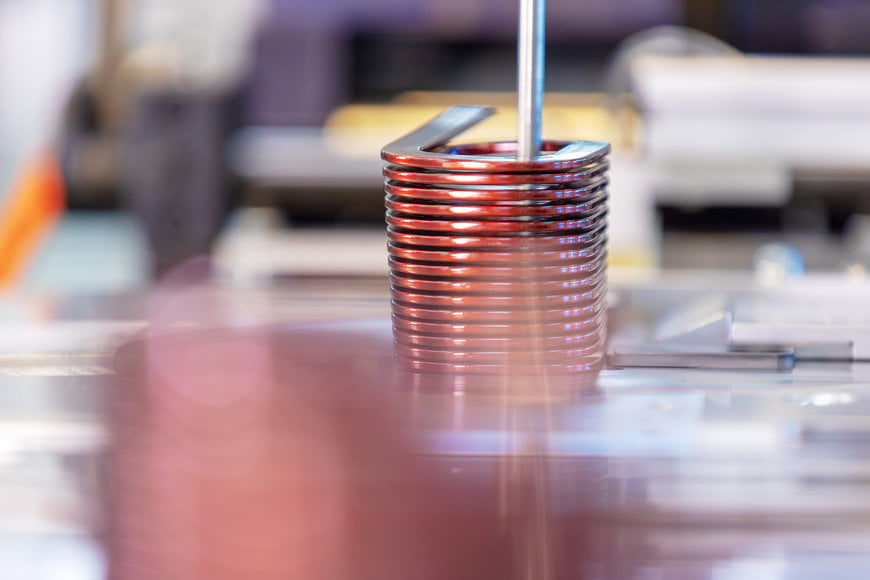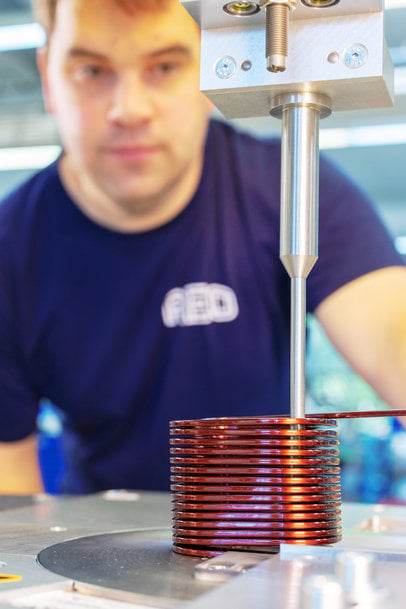www.industryemea.com
20
'22
Written on Modified on
Keeping wind turbines cool
How edge winding will boost cooling efficiency of wind turbines. As wind turbines get bigger and their generating capacity increases, they also generate more heat. Components including the frequency converter, generator and transformer are reaching the limits of traditional air-to-air and liquid-to-air cooling systems.

Here Steve Hughes, managing director of wind turbine component specialist REO UK, explains how edge-winding for inductive parts will boost cooling efficiency for the next generation of wind turbines.
A typical wind turbine generates heat from a variety of sources. The gearbox that acts as the bridge from the blade mechanism to the generator produces heat from friction, whereas the power converter, generator and transformer produce heat as a by-product of their efficiency losses. Even the sun can compound the problem by heating up the ambient air in and around the nacelle where these components are housed.

Traditionally, wind turbines used heat exchangers in a closed-loop system with forced air cooling. Here, fans are used to channel hot air from the electrical components to an aluminium heat exchanger where the fins transfer heat away from the nacelle — the closed loop mechanism keeps the two mediums separate, preventing dust, sand and salt mist from entering the nacelle.
The advent of turbines with capacities as large as 15 MW, means that air-to-air cooling is increasingly being replaced with liquid-to-air cooling systems. These use a closed-loop tubular cooling system to transfer a thermal fluid — typically an ethylene glycol aqueous solution — to increase the cooling efficiency.
However, not only does this require a complex network of pumps and ductwork, but the increasing complexity is also prone to increased maintenance requirements. Research published in the journal Wind Energy suggests that “An out-of-service turbine can cost $800-$1,600 USD per day, with most repairs taking 1-3 days.”
For REO, the answer is not about expanding the ambient cooling system, but rather improving the heat transfer directly from the core components themselves. At their core, most inductive components used in converters, generators and transformers are either wound using round copper wire or using copper or aluminium foil.
Picture it like a roll of baking foil; as you unravel it, each layer of foil is the conductor carrying electricity and forming an inductor. If you use foil to wind an inductor you must maintain electrical separation between the layers. Not only does the layered approach take up more room, but the inner layers also invariably run a lot hotter than the outer layers. This means you must use a larger cooling system rated for the worst-case scenario.
This is where edge winding offers a distinct advantage. In the analogy above, it’s like taking the layer of foil and twisting it into a stranded wire or solid conductor and winding it edge-ways. Each winding is separated from one another and is uniformly heated. It also takes up 30 per cent less space, power loss is reduced by 25 per cent and weight by 10 per cent.
Edge winding of rectangular or square conductors allows higher current ratings for a given core size, with higher inductances. The window utilisation factor, which is the area inside the core, is up to 30 per cent higher and because the windings are side-by-side, cooling is greatly increased. Edge wound inductors generally have a lower parasitic capacitance than other methods of winding, which reduces unwanted high-frequency return paths, helping the products meet electromagnetic compatibility (EMC) standards.
Products such as REO’s N CNW 806 Dv/Dt choke are designed to filter over voltages that result from switching transients and our N CNW 903 three-phase mains choke is designed to filter harmonic frequencies and reactive power. All three of these problems generate heat in the wind turbine and it’s the edge winding used in these products that drastically improves the cooling function.
As wind turbines get bigger, fortunately the cooling systems don’t have to grow exponentially. By addressing the source of the heat and using innovations like edge-winding, we can continue to keep our wind turbines cool.
To find out more about edge-winding and how to keep your wind application cool, visit the REO edge-winding page or download the wind turbine brochure.
www.reo.com

